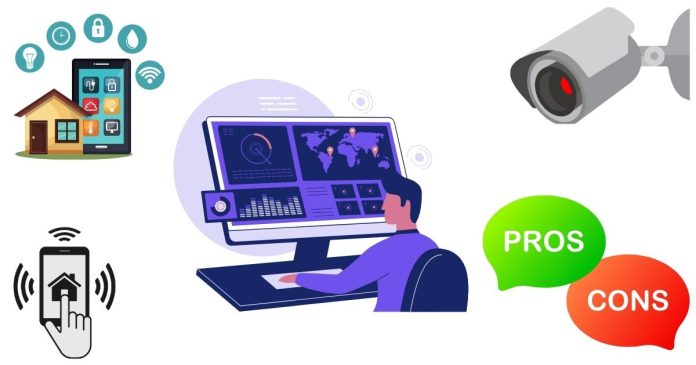When it comes to protecting your home and loved ones, choosing the right home security system is one of the most important decisions you can make. With so many options on the market—ranging from traditional systems with professional monitoring to newer DIY setups—homeowners have a variety of choices to suit their needs and budget.
This article will explore the pros and cons of some of the most popular home security systems available today, helping you make an informed decision.
1. SimpliSafe: The Popular DIY Choice
SimpliSafe is a favorite among homeowners looking for an affordable and straightforward DIY system. It’s easy to set up and requires no professional installation.
Pros:
- Easy setup with no tools or professional installation required.
- Affordable pricing, with no long-term contracts.
- Highly customizable packages with door sensors, motion detectors, cameras, and more.
- Optional professional monitoring at competitive rates.
- Cellular connectivity ensures the system works even during power outages.
Cons:
- Limited smart home integrations compared to other systems.
- Equipment is sold separately, so costs can add up if you want advanced features.
- No outdoor camera included in the base package (must be purchased separately).
Best For: Renters or homeowners looking for a no-fuss DIY system with the option of professional monitoring.
2. Ring Alarm: A Smart Home Favorite
Ring Alarm is part of the Amazon ecosystem and is well-known for its smart home compatibility and user-friendly design.
Pros:
- Affordable starter kits with expandable options for larger homes.
- Integrates seamlessly with Ring doorbells and cameras.
- Works with Alexa for voice control and automation.
- Professional monitoring available at a low monthly cost.
- User-friendly app for easy control and notifications.
Cons:
- Heavily reliant on the Amazon ecosystem (better for Alexa users than Google Assistant users).
- Limited third-party device compatibility compared to other systems.
- Privacy concerns related to Amazon’s ownership and past security controversies.
Best For: Tech-savvy homeowners who already use Alexa and Ring products.
3. ADT: The Classic Professional Monitoring System
ADT has been a leader in home security for decades, offering professional installation and 24/7 monitoring.
Pros:
- Extensive experience and trusted brand in the industry.
- Professional installation ensures the system is set up correctly.
- Robust monitoring network with fast response times.
- Integrates with smart home devices like smart locks, thermostats, and cameras.
- Wide range of equipment options, including indoor and outdoor cameras.
Cons:
- Requires long-term contracts (typically 36 months).
- Expensive compared to DIY systems.
- Professional installation fees can be steep.
- Less flexible for renters or those who frequently move.
Best For: Homeowners looking for a reliable, full-service security system and don’t mind paying for professional monitoring.
4. Vivint: High-Tech and Fully Integrated
Vivint stands out for its advanced technology and sleek, modern equipment. It’s an excellent choice for homeowners who want a fully integrated smart home and security system.
Pros:
- State-of-the-art equipment with a sleek, modern design.
- Fully customizable system with indoor/outdoor cameras, doorbell cameras, and smart home features.
- Professional installation included.
- Intuitive mobile app for managing your system.
- Integrates with Google Assistant, Amazon Alexa, and Z-Wave devices.
Cons:
- High upfront costs for equipment and installation.
- Long-term contracts required for monitoring.
- Expensive monthly monitoring fees compared to competitors.
Best For: Homeowners who want a high-tech, integrated system and are willing to invest in premium features.
5. Wyze Home Monitoring: Affordable Smart Security
Wyze is a newer player in the home security space, offering a budget-friendly system with basic features.
Pros:
- Extremely affordable equipment and monitoring plans.
- Compact and easy-to-install devices.
- Integrates with other Wyze products (like cameras, lights, and plugs).
- No contracts required.
Cons:
- Limited features compared to more established brands.
- Fewer smart home integrations (primarily works with Google Assistant and Alexa).
- Not as robust for larger homes or those requiring advanced features.
Best For: Budget-conscious homeowners or renters looking for a simple system.
6. Nest Secure (Discontinued but Still Used by Many)
Google’s Nest Secure was a sleek, high-tech system that many homeowners loved. While it was discontinued in 2020, some people still use it, and replacement parts are available.
Pros:
- Sleek design that blends with modern interiors.
- Integrates seamlessly with Google Assistant and other Nest products.
- Easy DIY installation.
Cons:
- Discontinued, meaning limited support and future updates.
- Replacement parts or repairs may become difficult over time.
Best For: Existing Nest product users who still have functioning systems.
How to Choose the Right Home Security System
When deciding on a home security system, consider the following factors:
- Budget: Are you looking for an affordable option, or are you willing to pay more for advanced features?
- Monitoring: Do you want professional 24/7 monitoring, or is a self-monitored system sufficient?
- Smart Home Compatibility: If you use Alexa, Google Assistant, or other smart devices, ensure your security system integrates seamlessly.
- Installation: Would you prefer a DIY setup, or are you okay with paying for professional installation?
- Flexibility: Renters may need systems that don’t require drilling or long-term contracts.
From budget-friendly DIY options like SimpliSafe and Wyze to high-tech, professionally installed systems like Vivint and ADT, there’s a home security system for every type of homeowner. The best choice depends on your needs, lifestyle, and how much you’re willing to invest in peace of mind.
So, what system do you use? Share your experiences, pros, and cons in the comments below to help others make the best decision for their home security!



